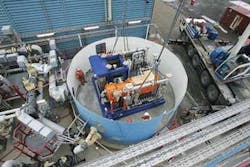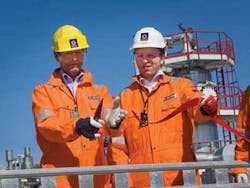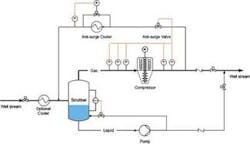Subsea compression under review to safeguard Åsgard flow assurance
Nick Terdre, Contributing Editor
A compressor test program under way in western Norway could lead to application of the world’s first subsea compression system. The qualification program, which is being conducted at StatoilHydro’s K-lab facility, involves new compressor designs developed by vendors MAN Turbo and Siemens.
The program is part of the work of the Åsgard Minimum Flow Project, created in 2005 to identify the minimum flow required in the Åsgard gas pipelines to avoid slug formation and to devise measures that would enable the flow to be kept above the critical level. Subsea compression is thought to offer the best solution, if the technology can be qualified.
StatoilHydro’s plan is to install two 8-10 MW subsea compressor stations on the Midgard gas/condensate field, which is tied back to the Åsgard B gas platform. Production from the Mikkel gas/condensate field also is delivered to Åsgard B via Midgard.
Some 40 bcm (1.4 tcf) of gas from the two fields would be produced through the compression facilities, of which 15 bcm (520 bcf) would be additional recovery otherwise realized, according to Rolv Herfjord. In the process, Midgard recovery would climb to 80% or higher and Mikkel’s to 70% or more.
Alternatives involving topside compression facilities also are under review – such solutions do not require technology qualification. Here there are two options: locating the facilities on Åsgard B or on a dedicated platform on Midgard. Both have drawbacks. For the Åsgard B option, compression situated at the destination would be less effective than compression at the source, so additional recovery would be lower. However, a dedicated platform on Midgard would be significantly more costly than subsea facilities.
Qualification targets
The Åsgard project forms part of a stepwise program initiated by Statoil in the early years of this decade to qualify subsea processing technology. The program consists of five main stages:
- 1) Subsea separation on the Tordis field, which came onstream early this year
- 2) Subsea injection of raw seawater on the Tyrihans field, due onstream in 2009
- 3) Åsgard subsea compression, involving a medium range stepout and medium power requirement, onstream in 2013 at the earliest
- 4) Snøhvit subsea compression, involving a long stepout and high power requirement, onstream during 2015-20
- 5) Qualified technology for long stepouts and even higher power requirements, for use in arctic field production post-2020.
StatoilHydro is running another project to qualify subsea compression – the Ormen Lange pilot. This was started originally by Norsk Hydro, which merged with Statoil to form StatoilHydro last October. The requirements for Ormen Lange are similar to those for Snøhvit, with the additional challenge of a water depth of around 850 m (2,789 ft).
Qualification of the subsea separation system for Tordis, an oil field with associated gas, involved extensive testing. Tyrihans, although it represents StatoilHydro’s first use of raw seawater injection subsea for maintaining reservoir pressure, essentially employs qualified equipment such as subsea booster pumps and subsea injection pumps, and therefore does not entail a substantial advance in technology.
However, a major step forward is needed in terms of qualification if subsea compression is to become a reality. Herfjord is cautious concerning the outcome of the project. “I can give you no guarantee that there will be subsea compression on Åsgard,” he says. “There is a major technology gap to be closed.”
Performance issues
Compressors installed on land or on the topsides of an offshore platform are designed with easy access for maintenance of equipment such as seals, gearbox, couplings, and lubrication systems. In a subsea setting, access is difficult and costly, and repairs cannot be carried out on the seabed, so an entirely different design philosophy is called for.
The subsea compressor also presents a tougher challenge. While a topside compressor is fed dry gas with extraneous material taken out, the subsea unit has to deal with wet gas containing condensate and natural gas liquids, and whatever else comes out of the well – sand, for instance.
Arriving at the subsea compression station, the wellstream will pass through a scrubber which will separate the gas from the liquids, but this process is not expected to be 100% efficient. For these reasons, the subsea compressor must be both reliable and robust. For the Åsgard project, the requirement is five years of maintenance-free operation.
During earlier research, Statoil decided that the machine best suited for subsea operation would be a wet gas centrifugal compressor. A guiding principle for the design has been simplification. A high-speed motor is used, which means that no gears or couplings are necessary to connect it to the compressor shaft. The motor is moreover integrated with the compressor, rendering seals unnecessary. The use of magnetic bearings makes it possible to adopt cooling methods other than lubricating oil.
Integration of the motor and compressor also helps make the unit compact, reducing the footprint of the subsea compression station and facilitating installation. Compared with a conventional compressor weighing around 90 tons (81.6 metric tons), the units developed for the Åsgard testing weigh around 55 tons (49.9 metric tons), with a footprint 50-60% as big. The designs of the subsea compressor station are also modular to facilitate retrieval of components and sub-systems, rather than the whole compressor train, in the event of a malfunction.
For the Åsgard application the focus is on the compressor. The technology is to be qualified for a 50-km (31-mi) stepout, which, allied with the 8-10 MW power requirement for each unit, means that key parts of the power system such as the frequency converter and variable-speed drive can be installed on the platform and the power supplied as alternating current, the form in which it is consumed.
For the next step of technology development involving longer stepouts and higher power requirements, these parts will have to be installed subsea, which presents further stiff qualification challenges.
Vendor review
The project started off with four compressor vendors: Dresser Rand, GE/NuovoPignone, MAN Turbo, and Siemens. Of the two selected to supply compressors for the test phase, MAN Turbo’s unit is the first to undergo testing, while the Siemens unit will be subjected to the same test program in 2009.
MAN Turbo’s wet gas compressor unit is based on its HOFIM design, proven for operations with dry gas. The company has 20 years’ experience developing compressor technology and more than 50 compressor units in operation, with an accumulated running time of over 500,000 hours.
The wet gas compressor unit is a modular concept with few key components. The casing is hermetically sealed and process gas is used to cool the motor. The cooling gas is extracted from the process gas as it passes through the scrubber.
The motor stator and heavy-duty rotor are designed for operation in wet or corrosive gas environments. The motor has undergone testing with both thermodynamic and rotodynamic measurements being taken, with satisfactory results, according to the company.
While the MAN Turbo unit operates in a horizontal position, the Siemens compressor is mounted vertically. Siemen’s compressor design for subsea service is Eco II, an integrated electric motor seal-less centrifugal compressor. The motor is canned to keep it separate from the process gas. After undergoing extensive pilot testing, an Eco II prototype developed in a project for Shell has been in operation on the Vries-4 section of the onshore Groningen field in the Netherlands since 2007.
The Siemens unit uses oil as a cooling medium for the canned parts. The oil itself is cooled by passing seawater over the surface of the cans by means of a closed loop.
Test program
The test program began in April at StatoilHydro’s K-Lab, which is integrated into the Kårstø gas terminal in western Norway. K-lab underwent a NKr 250 million ($48.9 million) upgrade for the project. This involved installing new power facilities capable of delivering up to 20 MW and a 12-in. (30-cm) test line rated for pressures up to 150 bar (15 MPa) and a gas flow of up to 6,000 cm/hr (211,888 cu ft/hr), according to manager, Trond Austrheim.
Gas from the Kårstø plant is used for the test program. To set a benchmark, in an initial phase the gas loop will be saturated with liquid to give a low liquid content. When this is completed, liquid will be injected into the gas flow to give a liquid content of 2-3%, equivalent to that found on the Midgard and Mikkel fields.
Each compressor unit will be run for 3,000-4,000 hr over six to seven months. For each unit the first task will be to confirm its power duty and performance. This has been done already in the case of the MAN Turbo unit, Herfjord says. The machines will then be run under a variety of operational conditions.
A multi-phase meter has been installed on the gas line downstream of the separation scrubber. This will measure the volume of gas and check the efficiency of the separation process. Maximum pressure to be applied in the test program is 140 bar (14 MPa). The target for the compressors is to achieve a compression ratio of up to about two. In other words, pressurizing the gas flow to twice the suction pressure with which it enters the compression facility.
Other suppliers to the project include ABB (power distribution system), FMC Technologies (control system), and Tronic and Vetco Gray (connectors and penetrators). Aker Solutions performed a pre-FEED system study. In 2009 the project team also plans a qualification program with equipment supplied by ABB to simulate the power supply over the 50-km (31-mi) stepout.
Marinization of the equipment is being taken care of mainly in the work now being done by vendors to qualify their equipment, Herfjord says. However, the penetrator and connector – critical items which will connect the power cable to the compressor motor, an operation to be performed subsea – will be tested underwater.



